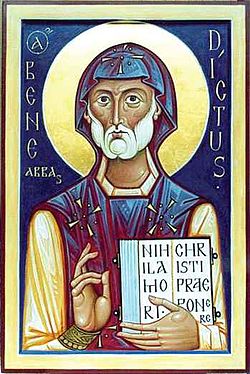Portal:Catholic Church/Patron Archive/July 11
Benedict of Nursia (Latin: Benedictus Nursiae; Italian: Benedetto da Norcia; 2 March 480 – 21 March 547), often known as Saint Benedict, was a Christian monk. He is famed in the Catholic Church, the Eastern Orthodox Church, the Lutheran Churches, the Anglican Communion, and Old Catholic Churches. In 1964, Pope Paul VI declared Benedict a patron saint of Europe.
Benedict founded twelve communities for monks at Subiaco in present-day Lazio, Italy (about 65 kilometres (40 mi) to the east of Rome), before moving southeast to Monte Cassino in the mountains of central Italy. The present-day Order of Saint Benedict emerged later and, moreover, is not an "order" as the term is commonly understood, but a confederation of autonomous congregations. (Full article...)
Attributes: Bell, broken tray, broken cup and serpent representing poison, broken utensil, bush, crosier, man in a Benedictine cowl holding Benedict's rule or a rod of discipline, raven
Patronage: Against poison, against witchcraft, agricultural workers, cavers, civil engineers, coppersmiths, dying people, erysipelas, Europe, farmers, fever, gall stones; Heerdt, Germany; heraldry and Officers of arms; Institute of Christ the King Sovereign Priest; inflammatory diseases; Italian architects; kidney disease; monks, nettle rash; Norcia, Italy; people in religious orders; San Beda University; schoolchildren and students; servants who have broken their master's belongings; speleologists; spelunkers; temptations

